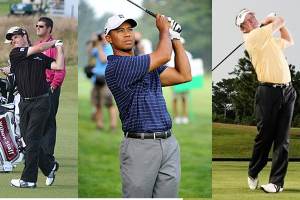Golfers Swing into Summer with Chiropractic Care

PGA golfers Tiger Woods and Padraig Harrington have relied on chiropractic care for years to stay healthy and to improve their performance over the course of their professional careers. Fred Funk and Suzann Pettersen have too. So have a great many others. So there’s really little doubt that elite golfers (and their coaches and trainers) recognize the value of chiropractic care. But what about the weekend warrior? Can chiropractic care help the average golfer play better, longer and with fewer injuries?
If you’re a golfer, you might already know first-hand that your musculoskeletal health plays a huge role in your enjoyment of the sport as well as your performance.
One of the most important things to understand is that the biomechanics of your golf swing can affect your health (back, hips, neck, elbows, etc.) and vice-versa—that your health can affect your swing. It’s really a feedback loop that can have either a positive or negative effect on your game over time.
Many professionals around the broader golf community—from instructors and trainers to healthcare providers who specialize in sports medicine—are becoming increasingly interested in this feedback loop. The Titleist Performance Institute (TPI) is one very good example:
“…TPI has analyzed how physical limitations in a player’s body can adversely affect the golf swing and potentially lead to injury.”
“TPI’s mission is to educate golfers and industry professionals on the body/swing connection…”
Let’s talk health first.
The very nature of golf and the biomechanics associated with swinging a club make chiropractic care a great fit for golfers. Golfing can involve considerable strain on the spine as a result of the need to generate club head speed. This requires good swing mechanics—posture, balance and timing. Poor swing mechanics have the potential to create exaggerated or flattened spinal curves that can seriously affect performance. In fact, Tom Ward, PGA Golf Instructor, says, “Over 50% of all golfers will experience some sort of pain due to poor posture and the problems that arise from loss of proper curves in the spine.”
By helping to improve your spine’s stability and range of motion, chiropractic care can help prevent injuries and enhance swing performance. An individualized treatment plan including chiropractic adjustments combined with structured stretching and exercise programs may make a significant difference in how well you golf and how much you enjoy it—as well as in how long you’re able to play the game.
Now what about performance?
Recent research suggests that chiropractic care can indeed lead to improved golf performance. A recent study published in the Journal of Chiropractic Medicine demonstrated that the combination of chiropractic care and stretching are associated with greater improvements in golfers’ swings when compared to stretching alone.
Two groups of golfers participated in the study. One group received a program of stretching only, and the second received both stretching and spinal manipulation. The stretching program was the same for both groups, and both groups had similar average ages, handicaps, and initial swings. All 43 participants initially performed three full swing maneuvers, and the average distances were recorded. Over a 4-week period, all participants hit 3 balls before and after treatment.
After 4 weeks, the stretching only group showed no improvement in swing performance. However the stretching and manipulation group did improve their swing performance and there was greater driving distance right after treatment each week. So it appears that yes, chiropractic care can help not only top golfers such as Woods and Harrington, but it can help you improve your golf game too.
A good golf swing is the result of a complex combination of balance, flexibility and strength. And doing it repeatedly over the course of 18 holes (or even more in tournament play) takes a high degree of conditioning as well. If you’re serious about golf, chiropractic care can help you play better, play longer and avoid injuries while you’re doing it!
Call or visit our office today to learn more!

